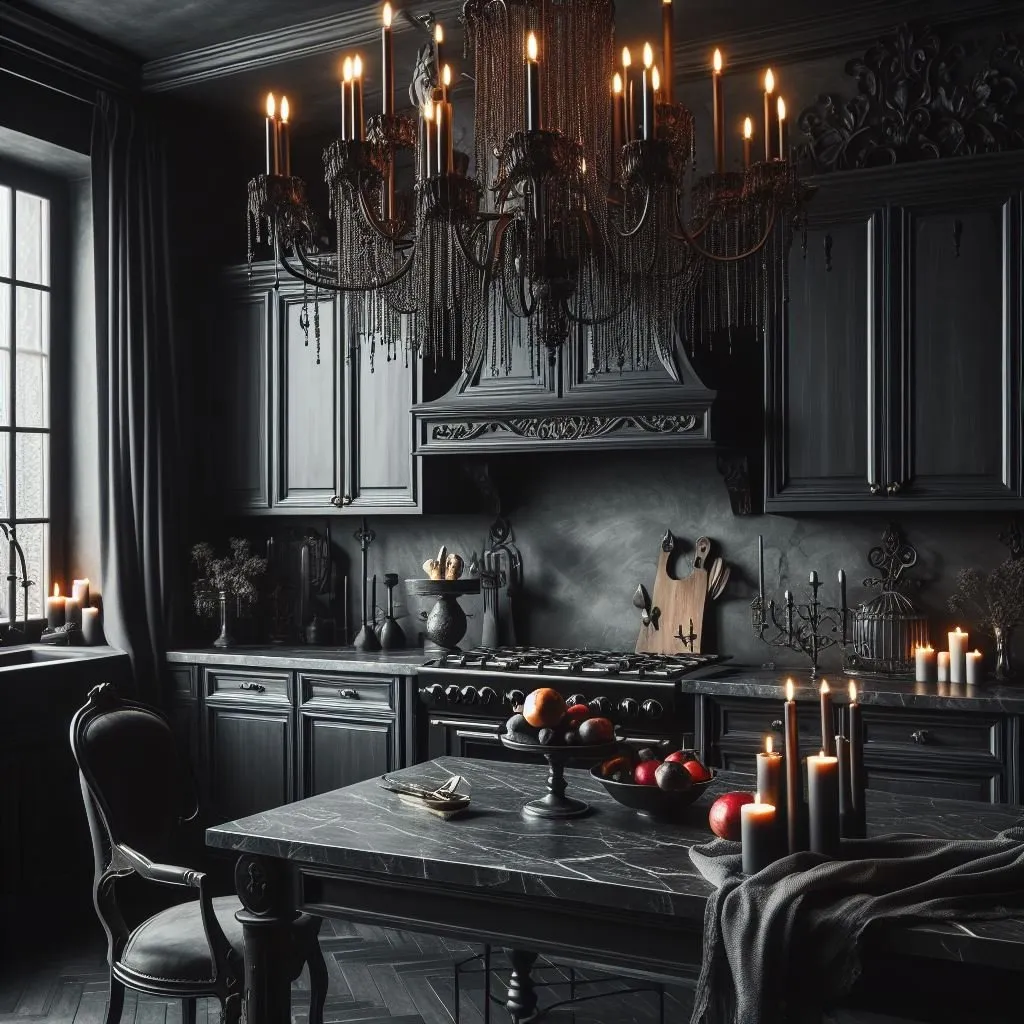Gothic Kitchen Design: Embrace the Dark Side
Transforming your kitchen into a gothic sanctuary is a bold and exciting design choice. It’s about creating a space that is both dramatic and inviting, a place where you can express your unique style and appreciate the beauty of the unconventional. The gothic aesthetic draws inspiration from medieval architecture and art, emphasizing rich textures, intricate details, and a sense of mystery. Think of dimly lit spaces, elegant furnishings, and a touch of the macabre, all while maintaining functionality and comfort. This guide will provide top 5 design ideas to help you create the gothic kitchen of your dreams, combining timeless style with modern practicality. Get ready to embrace the shadows and create a kitchen that is as captivating as it is functional. The gothic kitchen isn’t just a place to cook; it’s a statement.
Color Palette for a Gothic Kitchen
The color palette is the foundation of any gothic kitchen design. It sets the mood and atmosphere, immediately conveying the intended aesthetic. Gothic design thrives on depth and intensity, and a carefully chosen color scheme will bring your vision to life. The key is to choose colors that evoke a sense of drama and mystery, creating a captivating environment. From the walls to the cabinets and accessories, the colors you choose will play a huge role in the overall experience. Consider the lighting and the materials you are using, as they will influence how the colors appear. The ideal gothic kitchen color palette balances darkness with accents to create an intriguing and functional space.
Deep and Dramatic Colors
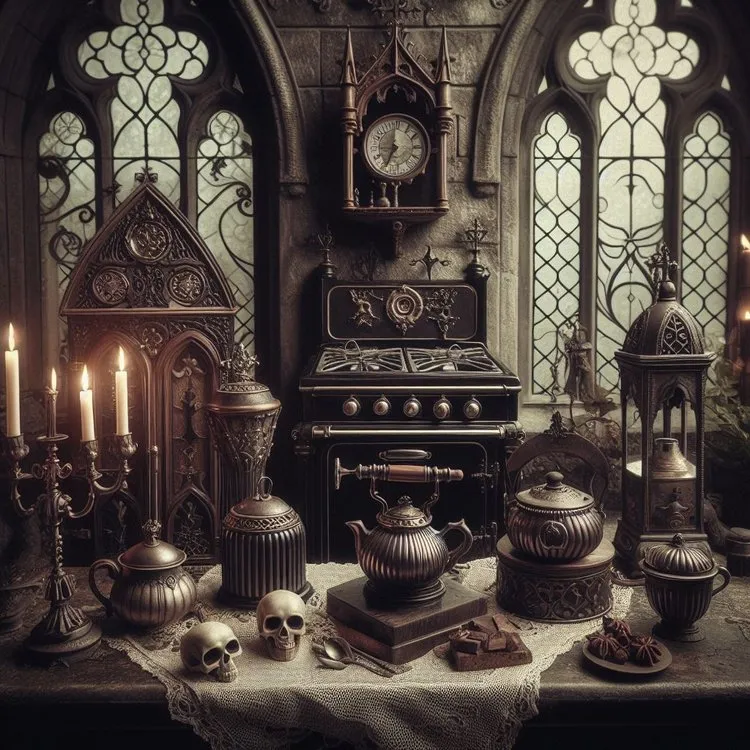
Deep, saturated colors are the cornerstone of gothic design. Think of shades like charcoal gray, deep burgundy, forest green, and navy blue. These colors create a sense of depth and sophistication, establishing a mood that is both mysterious and elegant. Black is also a powerful choice, particularly for cabinetry or accent walls, but be mindful of balancing it with lighter elements to prevent the space from feeling too closed in. Consider using these colors on your walls, kitchen cabinets, and even appliances. The use of dark colors not only adds depth but also creates a perfect backdrop for gothic accessories, allowing them to truly stand out. The key is to use these colors thoughtfully, ensuring the space remains welcoming and functional.
Earthy Tones and Textures
While deep colors dominate, earthy tones add warmth and balance to a gothic kitchen. Incorporate shades like dark browns, deep reds, and even touches of gold or bronze to introduce texture. Consider using natural materials like wood and stone, which can bring an organic feel to the kitchen while staying true to the gothic aesthetic. These textures not only create visual interest but also provide contrast against the darker tones, preventing the kitchen from feeling too heavy. Using a combination of deep and earthy colors ensures the kitchen feels both dramatic and inviting, a space where one can feel inspired.
Furniture and Fixtures
The furniture and fixtures you choose can define the gothic style of your kitchen. Look for pieces that have intricate details and a touch of grandeur. Think of substantial pieces that are meant to last, representing the gothic love for longevity and craftsmanship. From the kitchen island to the dining table and chairs, each element should reflect the gothic spirit. Materials like dark wood, wrought iron, and stone are ideal. The furniture should be as functional as it is beautiful. The right pieces will not only enhance the aesthetic but also contribute to the overall atmosphere of your kitchen. The fixtures, such as faucets, handles, and cabinet hardware, should complement the overall look, adding to the gothic appeal.
Ornate Cabinetry
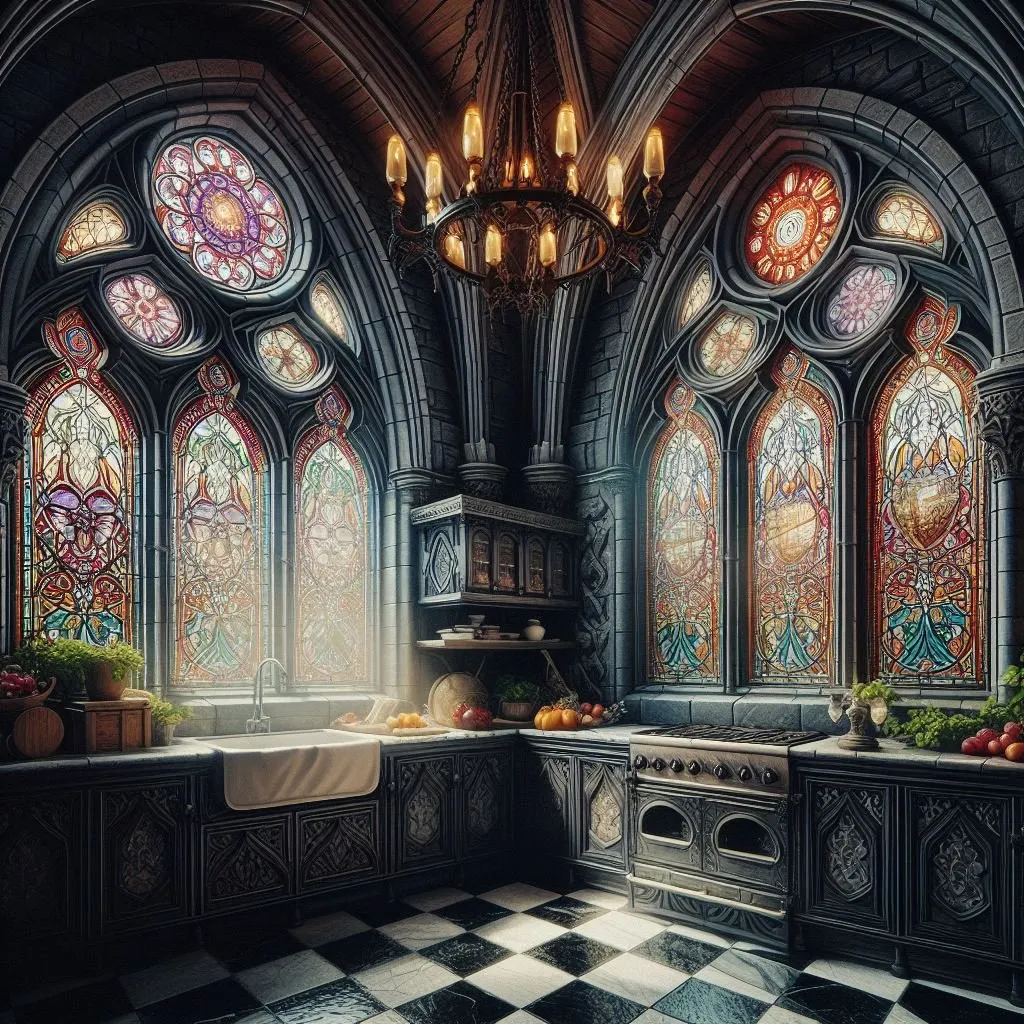
Ornate cabinetry is a hallmark of gothic kitchen design. Choose cabinets with intricate carvings, detailed paneling, and perhaps even a touch of gothic-inspired hardware. Dark-stained wood is a classic choice, but you could also consider painted cabinets in deep colors to create a more modern gothic look. The cabinets should be the centerpiece of the kitchen, providing both storage and a striking visual element. Consider incorporating elements such as arched doors, decorative molding, or even gothic-style hardware to further enhance the cabinets’ aesthetic appeal. The right cabinets can transform the entire kitchen and create a sophisticated and awe-inspiring space, making it a true gothic masterpiece.
Statement Lighting
Lighting is crucial in a gothic kitchen. Choose fixtures that are not only functional but also make a statement. Chandeliers with intricate designs, wrought-iron pendants, or sconces with dramatic detailing are all excellent choices. The lighting should be able to create a layered effect, combining ambient, task, and accent lighting to enhance the atmosphere. Consider using dimmers to adjust the light levels, creating a soft and inviting ambiance. The type of lighting can greatly affect the look and feel of the kitchen. By incorporating statement lighting, you can dramatically elevate the space and add a touch of gothic elegance. The right lighting can set the mood and enhance the overall aesthetic.
Accessorizing Your Gothic Kitchen
Accessories are the final touch to bring your gothic kitchen to life. They add personality and style, and the right pieces can complete the space. Consider elements that evoke a sense of history and mystery. From the countertops to the backsplashes and decorations, gothic accessories should be chosen with care. Don’t overload the space with too many items; instead, focus on quality pieces. The items you select should reflect your personality, from gothic figurines to vintage artwork. The key is to incorporate items that enhance the overall aesthetic and create an environment that feels both beautiful and personal. Incorporating these small details can transform a functional kitchen into a gothic sanctuary.
Gothic Decor Elements
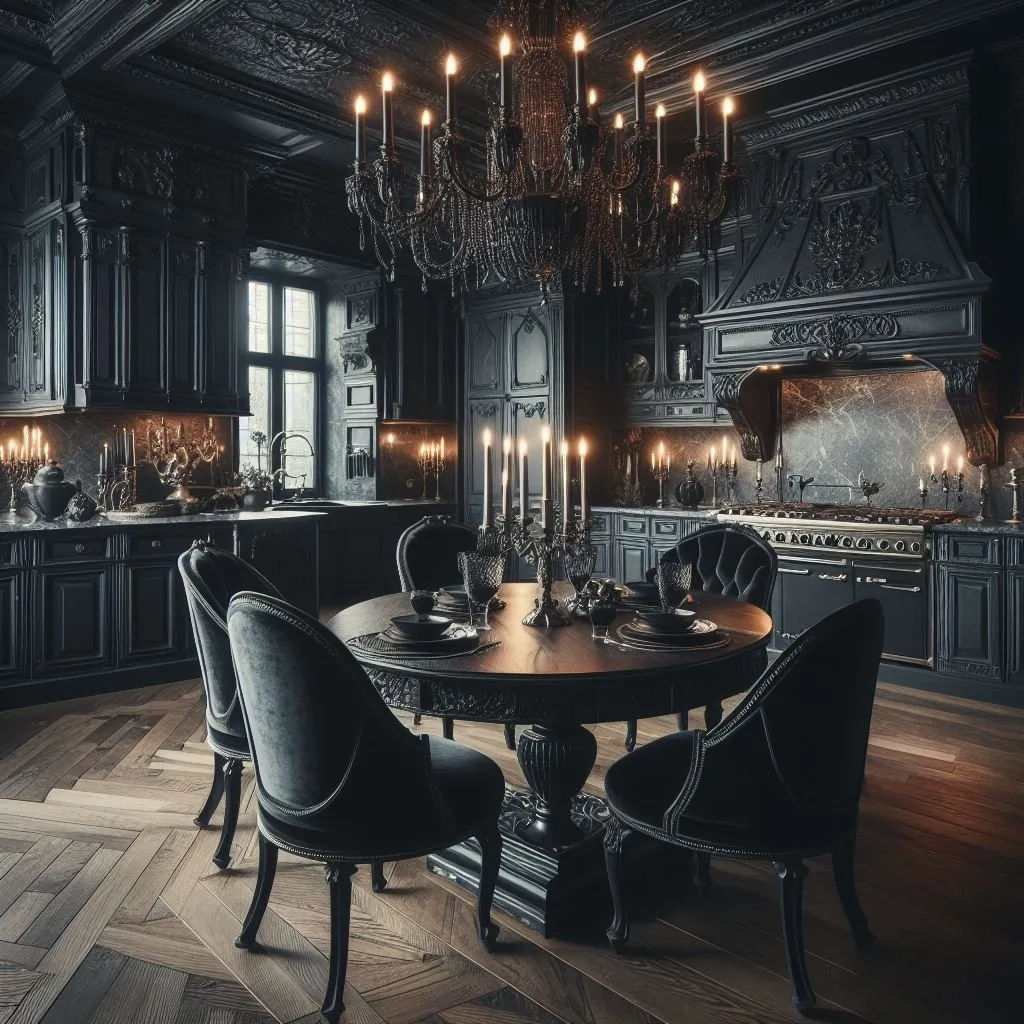
Introduce gothic decor elements to enrich your space. Consider wrought-iron candle holders, antique mirrors with ornate frames, and gothic-inspired artwork. Place a vintage candelabra on the dining table or a striking mirror on the wall to enhance the kitchen’s aesthetic appeal. Incorporate small details, such as gothic figurines or decorative plates, to add character to the space. You could also include gothic-style clocks, serving trays, and other small accessories to complement the overall design. The decor should be unique and reflective of the gothic aesthetic. The accessories you choose will highlight your individual taste and help bring the overall vision together.
Textiles and Fabrics
Textiles can add a touch of luxury and warmth to a gothic kitchen. Think of velvet curtains, plush cushions for your dining chairs, and even a patterned rug. Choose fabrics in deep, rich colors that complement the overall color scheme. Consider incorporating patterns and textures such as damask or brocade to enhance the gothic aesthetic. Textiles can soften the look of the kitchen, adding a sense of comfort and sophistication. By incorporating textiles, you can add layers of depth and dimension to your space. These additions will create an inviting and comfortable gothic kitchen, where you can enjoy both beauty and functionality.
Incorporating Modern Elements
Even in a gothic kitchen, modern elements can be incorporated to enhance functionality and appeal. The key is to balance the gothic aesthetic with modern convenience. It’s about integrating the traditional charm of gothic design with the contemporary features of modern living. This is a balancing act, ensuring that your kitchen not only looks beautiful but is also functional and comfortable for everyday use. You can seamlessly integrate modern appliances, sleek countertops, and efficient storage solutions without sacrificing the gothic feel. The combination of gothic charm and modern practicality will create a kitchen that is both stunning and perfect for your daily routines.
Blending Gothic with Modern Minimalism
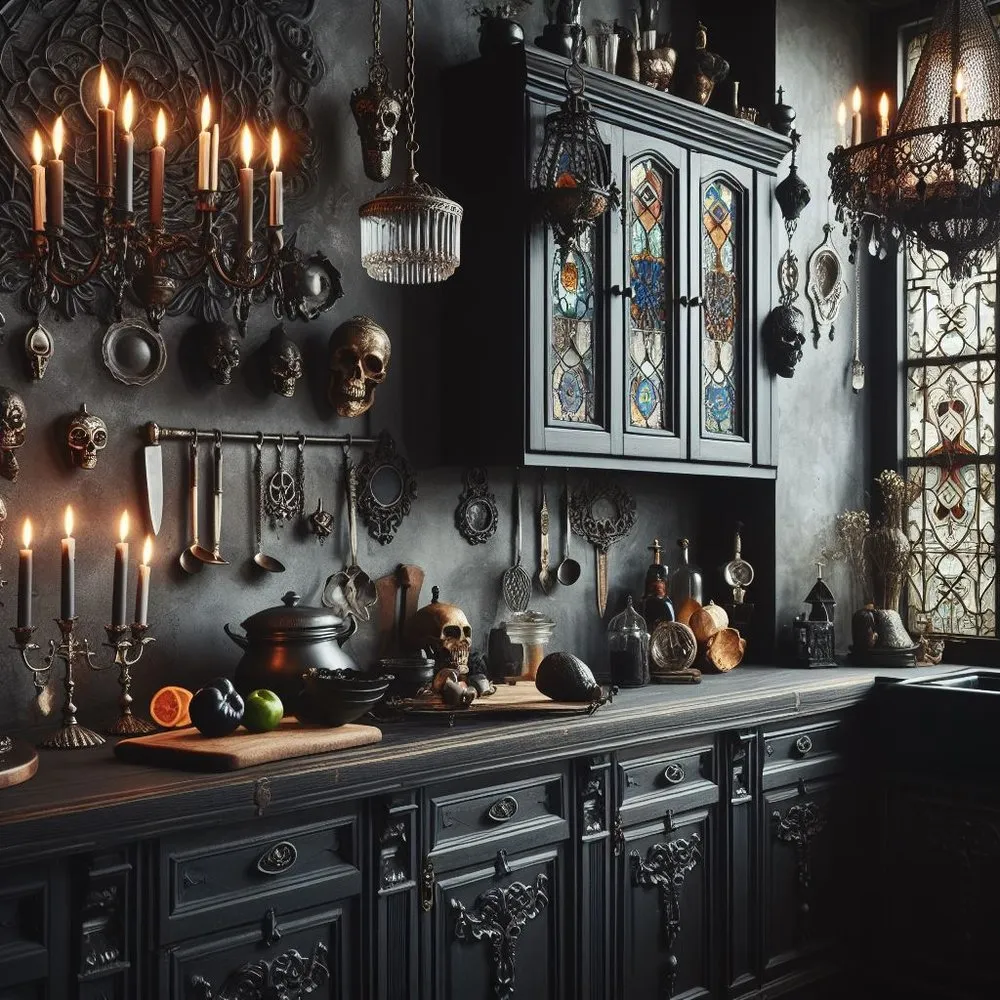
Consider blending gothic design with modern minimalism. This approach involves incorporating the dramatic elements of gothic style with the clean lines and simplicity of minimalist design. Choose sleek, modern cabinetry in dark colors, and incorporate gothic details such as intricate hardware or decorative molding. Pair these with minimalist countertops, such as concrete or quartz, to create a balanced aesthetic. This allows you to enjoy the best of both worlds, offering a sophisticated, less cluttered space. The merging of these two styles results in a kitchen that’s both visually stunning and functional, perfect for those who appreciate elegance and simplicity.
Using Metallic Accents
Metallic accents can bring a touch of modernity to your gothic kitchen. Incorporate gold, brass, or copper finishes on faucets, cabinet hardware, and lighting fixtures. Metallic accents can add a touch of glamour and sophistication to the kitchen, and they also provide a visual contrast against the darker colors. Using metal accents to update your kitchen creates an engaging space. These accents can also enhance the overall sense of luxury and elegance in the space. The use of metals will help you create an exquisite and modern gothic kitchen.
Maintenance and Care
Maintaining a gothic kitchen requires some specific care, especially when it comes to materials such as dark wood and ornate details. Regular cleaning with appropriate products will help maintain the beauty of your kitchen. For dark wood cabinetry, use a wood cleaner and polish to protect the finish. Clean any metal accents with the recommended cleaners to avoid tarnishing and maintain shine. Properly caring for your accessories will help ensure that your gothic kitchen remains both beautiful and functional for years to come. By following these guidelines, you can ensure that your gothic kitchen remains a stunning and inviting space for many years.
